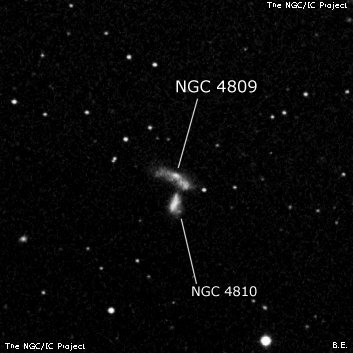
R.J. Mitchell discovered NGC 4809, along with NGC 4810, on 18 Apr 1855 while looking for h1509 [NGC 4900] with LdR's 72". He described a "faint, double nebula, elongated at right angles to each other." He gave a rough position of 12 48.5 (1860) and stated it was "a little north of [NGC 4900]."
Mitchell's description pins down the identification of the pair, but John Herschel and Dreyer could only list a single (rough) position in the GC and NGC. The identification of NGC 4809 with the northern component is from the RC2 and repeated in the NGC 2000.0 and RNGC. But UGC reverses these identifications and has a typo with the RA (1 min too large). The data (size, PA and possibly magnitudes) listed under NGC 4810 in the RC3 applies to NGC 4809. The position angle listed under NGC 4809 probably applies to NGC 4810.
400/500mm - 18" (3/30/05): very faint, very small, slightly elongated. This galaxy is nearly attached to the north side of NGC 4810. Although smaller (must have viewed only a portion as the size is larger on the DSS), it may have a higher surface brightness.
900/1200mm - 48" (5/4/16): at 610x; moderately bright, elongated 7:2 WSW-ENE, ~1.2'x0.35'. This galaxy has an unusual irregular "banana" shape with a patchy appearance; it bends slightly south on the east-northeast end and has a blunter west-southwest end that also twists slightly south. There is a slightly brighter patch that is offset just north of the geometric center. I assumed this was the core region, but on the SDSS it appears to be a large HII region and there is no central core. A second slightly brighter patch is at the west-southwest end and this is clearly an active star-forming complex on the SDSS. NGC 4809 is the larger member of an interacting pair with NGC 4810 just 0.8' S.
Notes by Steve Gottlieb